ISSN ONLINE(2278-8875) PRINT (2320-3765)
ISSN ONLINE(2278-8875) PRINT (2320-3765)
| Shervin Samimian Tehrani1, Peyman Salmanpour Bandaghiri2 Student, Amirkabir University of Technology, Tehran Polytechnic, Iran |
| Related article at Pubmed, Scholar Google |
Visit for more related articles at International Journal of Advanced Research in Electrical, Electronics and Instrumentation Engineering
This paper presents the Simulation ofa14-bus system using STATCOM compensated by applying the error and see the impact of the voltage compensator buses. Voltage stability of a system is affected by reactive power limit of the system. FACTs devices improve the reactive power flow in system thereby improving voltage stability. This paper explores the effect of STATCOM on static voltage stability. IEEE-14 bus system has been used to demonstrate the ability of STATCOM in improving the voltage stability margin. These FACTs controllers help to increase the load ability margin of the power network. Modelling & simulation is performed using MATLAB SIM power system block set for evaluation.
Keywords |
| FACTS, STATCOM, Voltage Stability, applying the error. |
INTRODUCTION |
| With deregulation of electricity markets worldwide, there are good number of market players trying to engage in power buying and selling business. The sudden increase in peak demand and power transfer affects voltage security. In some of the incidents, voltage collapse was responsible for the outage. One of the major reasons for voltage instability is reactive power imbalance in the system[1]. This directly affects the load ability of a bus in a power network. In order to prevent a voltage collapse when system approaches load ability limit, a local reactive power support can immediately provide relief and enhance static voltage stability. The gradual change in power system leads to shortage of reactive power leading to reduce power stability. With increased power flow, there is corresponding decrease in voltage at the bus. Further increase in loading leads to shortage of reactive power. Thereafter, any further increase in active power transfer causes a quick decrease in magnitude of voltage of the bus. As the critical point is reached, heavy reactive power losses lead to a high voltage drop and there voltage collapse takes place. To prevent the system, reaching this state is to augment reactive power support or cut-off reactive power demand[2]. This phenomenon sometimes leads to major black-out [3].One of the methods to overcome this problem is to place reactive power support on the weakest bus 9 bus having lowest margin or near the collapse point. |
| Static synchronous compensators (STATCOMs) are part of the flexible alternating current transmission systems (FACTS) device family. Their primary purpose is to supply a fast-acting, precise, and adjustable amount of reactive power to the ac power system to which they are connected. STATCOMs achieve this by adjusting the magnitude and polarity (phase) of the reactive component of the current flowing through their ac side. This enables STATCOMs to control the amount and direction of flow of the reactive power exchanged with the ac power system. |
| The most recent approach for solid-state power compensators is based on self-commutated converters using components with a current blocking capability. Such a compensation system is the static equivalent of the synchronous compensator, hence the term STATCOM [4] (static synchronous compensator). A STATCOM can provide fast capacitive and inductive compensation and is able to control its output current independently of the AC system voltage (in contrast to the SVC, which can supply only diminishing output current with decreasing system voltage). This feature of the compensator makes it highly effective in improving the transient stability. Therefore STATCOM systems with GTO thyristors have been initially used for improving flexibility and reliability of energy transmission in FACTS (Flexible AC Transmission System) applications [5]-[6]. As the switching frequency of GTOs must be kept low, the control with fundamental frequency switching has been used and multi-phase configurations have been formed to reduce harmonics production. The newest applications of STATCOMs concern power quality improvement at distribution network level. Some examples given in the literature are the reduction of flicker, voltage control and balancing single phase load [7]-[8]. These are systems of a smaller power where IGBT or IGCT technology can be applied allowing fast switching with PWM control. |
| Although the possibility of using STATCOMs for the reduction of influence of disturbing loads on the supply network has already been proved in practice, there is still a lake of information about the complex assessment of compensation effectiveness and a method of system selection and its control for a given network. STATCOMs can be used for voltage compensation at the receiver end of ac transmission lines, thus replacing banks of shunt capacitors. When used for this purpose, STATCOMs offer a number of advantages over banks of shunt capacitors, such as much tighter control of the voltage compensation at the receiver end of the ac transmission line and increased line stability during load variations.STATCOMs are also commonly used for dynamic power factor correction (i.e., dynamic reactive power compensation) in industrial plants operating with large random peaks of reactive power demand. STATCOMs increase the power factor of the plant, minimize the voltage fluctuations at the plant input (which prevents damage to the equipment), and reduce the plant’s operating costs. |
| In this paper, the significance of the topological and reliability indicators is investigated by applyingthem on a case study regarding the characterization of the robustness and resilience properties of thetransmission network system of the IEEE (Institute of Electrical and Electronic Engineers) 14 BUS (aportion of the American Electric Power System) [9]. |
BASIC CONFIGURATION OF STATCOM |
| The STATCOM is a shunt device. It should therefore be able to regulate the voltage of abusto which it is connected. The operating principle of a STATCOM in this mode has been termed as the STATCOM in voltage control mode. In its most basic form, the STATCOM configuration consists of a VSC, adcenergy storage device; a coupling transformer connected in shunt with the ac system, and associated control circuits. Fig.1 shows the basic configuration of STATCOM. The VSC converts the dc voltage across the storage device into a set of three-phase ac output voltages. These voltages are in phase and coupled with the ac system through the reactance of the coupling transformer. Suitable adjustment of the phase and magnitude of the STATCOM output voltage sallows effective control of active and reactive power exchanges have been made to recover the situation with solutions based between the STATCOM and the ac system. The VSC connected in shunt with the ac system provides a multi functional topology which can be used for up to three quite distinct purposes: |
| ïÃâ÷ Voltageregulationandcompensationof reactivepower. |
| ïÃâ÷ Correctionofpowerfactor. |
| ïÃâ÷ Elimination of current harmonics. |
| As seen in Fig. 1, STATCOM is comprised of a coupling transformer, voltage basedinverter and DC energy storage element. If it is a rather small capacitor, energy storageelement can only be involved in reactive power exchange with the STATCOM line. If anaccumulator or another DC voltage resource is used in the place of the DC capacitor, energystorage element can be involved in active and reactive power exchange with the transmissionsystem. The voltage amplitude of the output and phase angle of STATCOM can be changed.The amplitude of AC output voltage basic component of an inverter can be controlled as V0=maVdc. Here, ma is the modulation index [10-12]. |
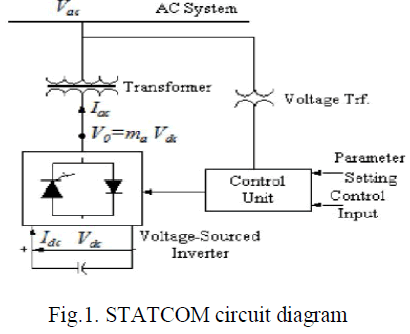 |
| V-I graphic of STATCOM under non-stop functioning condition was given in the Fig. 2. Thegraphic shows that the power system is provided with both inductive and capacitive flows inregular intervals. |
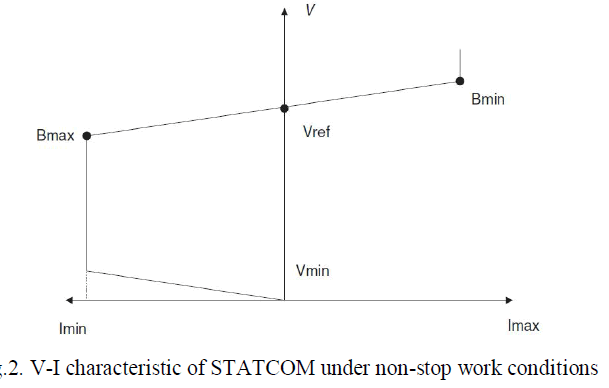 |
| The amplitude value of the flow from the inverter to the line can be calculated with the equation (1) below: |
 |
| whereXis the leakage reactance of the coupling transformer. Mutual exchange of reactive power can be stated in the equation (2) below: |
 |
| If the inverter output voltage in the system is beyond compared to AC system voltage, theinverter will provide active power from DC capacitor to the AC system. If the inverter outputvoltage in the system is behind compared to AC system voltage, the inverter will extractactive power from the AC system. The amount of active power exchanged constantly is rathersmall. The active exchange between voltage based inverter and AC system can be calculatedwith the equation (3) below: |
 |
PRINCIPLE OF STATCOM |
| STATCOM is to suppress voltage variation and control reactive power in phase with system voltage. It can compensate for inductive and capacitive currents linearly and continuously. Fig.3 shows the vector diagram at the fundamental frequency for capacitive and inductive modes and for the transition states from capacitive to inductive and vice versa. The terminal voltage (Vbus) is equal to the sum of the inverter voltage (VVSC) and the voltage across the coupling transformer reactive VL both capacitive and inductive modes. It means that if output voltage of STATCOM (VVSC) is in phase with bus terminal voltage (Vbus) and VVSC is greater than Vbus, STATCOM provides reactive power to system. If VVSC is smaller than Vbus, STATCOM absorbs reactive power from power system. Vbus and VVSC have the same phase, but actually they have a little phase difference to component the loss of transformer winding and inverter switching, so absorbs some real power from system. |
| Fig.3 is STATCOM vector diagrams, which show inverter output voltage VI, system voltage VT, reactive voltage VL and line current I in correlation with magnitude and phase δ. Fig.3 a and b explain how VI and VT produce capacitive or inductive power by controlling the magnitude for inverter output voltage VI in phase with each other. Fig.3 c and d show STATCOM produces or absorbs real power with VI and VT having phase ±δ. The transition from inductive to capacitive mode occurs by charging angle δ from zero to a negative value. The active power is transferred from the AC terminal to the DC capacitor and causes the DC link voltage to rise. The active and reactive power may be expressed by the following equations: |
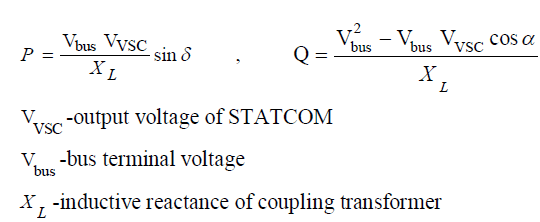 |
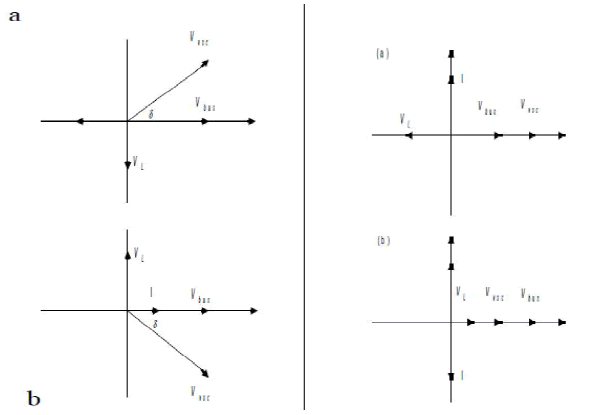 |
| Fig.3. Vectordiagram of STATCOM;(a)capacitive mode, (b)inductive mode, (c)active power release and (d) active power absorption. |
| A STATCOM is a voltage source inverter which converts DC input voltage into AC output voltage by which it regulates active and reactive power in the system. The AC voltage is controllable both in magnitude and phase. It can exchange active power if energy source is added on DC side. |
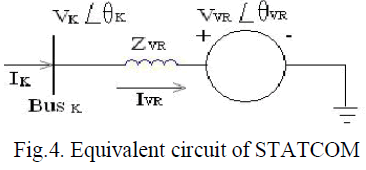 |
| STATCOM is represented as a voltage source for the full range of operation, enabling a better voltage support. The power flow equation are given by- |
 |
| Using these equations, linearized STATCOM model is given below, where voltage VVR and δVRphase angle are taken as state variable. |
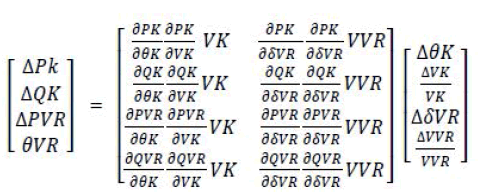 |
SIMULATION RESULTS |
| A single line diagram of the IEEE 14 bus test system is depicted in Fig.5. It consistsof five synchronous machines, including three synchronous compensators used only for reactive power support. Line data for the inspected system are provided in Tables 1. |
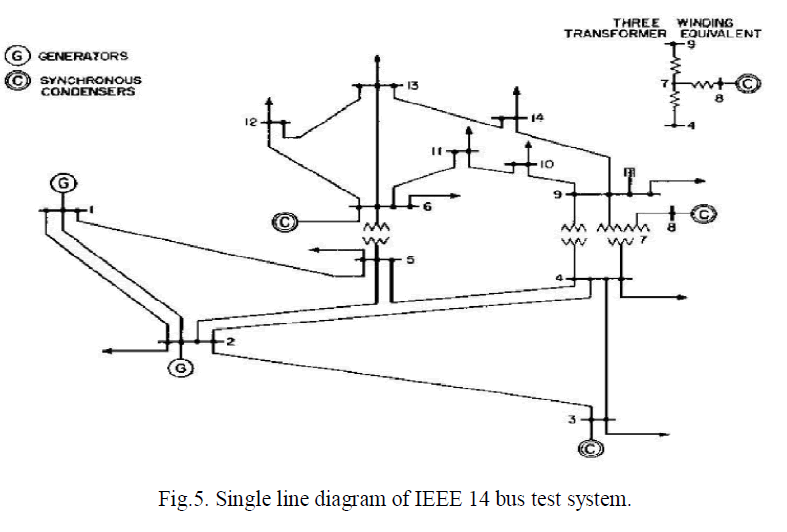 |
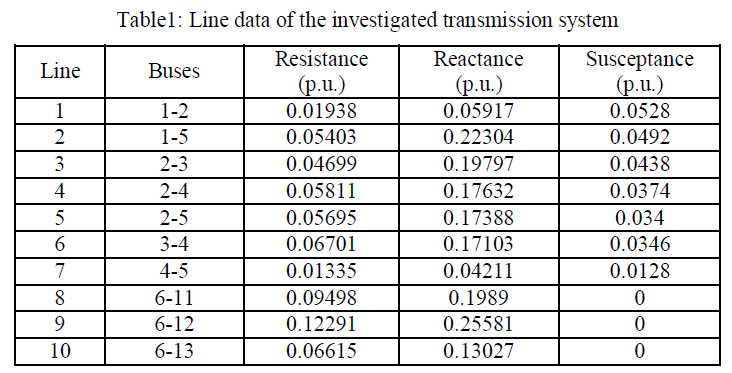 |
 |
| Fig.6, diagrams the bus voltage of the IEEE 14 bus system when the system error and without STATCOM is shown. As can see the voltage and oscillation damping is strong and can take a long time to reach its steady state value. Fig.7, diagrams the bus voltagewhen the system error with STATCOM is shown. As can see the STATCOM with real power capability can be very effective in damping power system oscillations and Voltage fluctuation is reduced. |
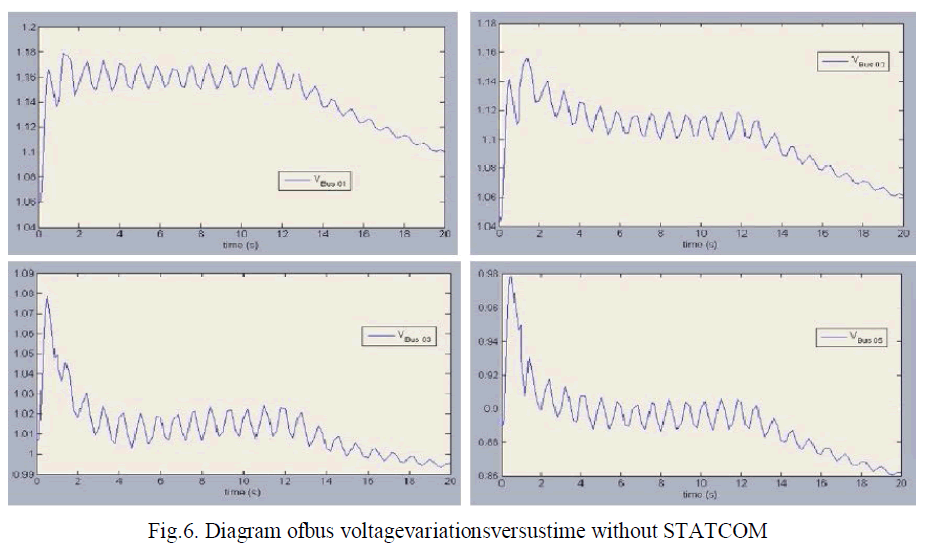 |
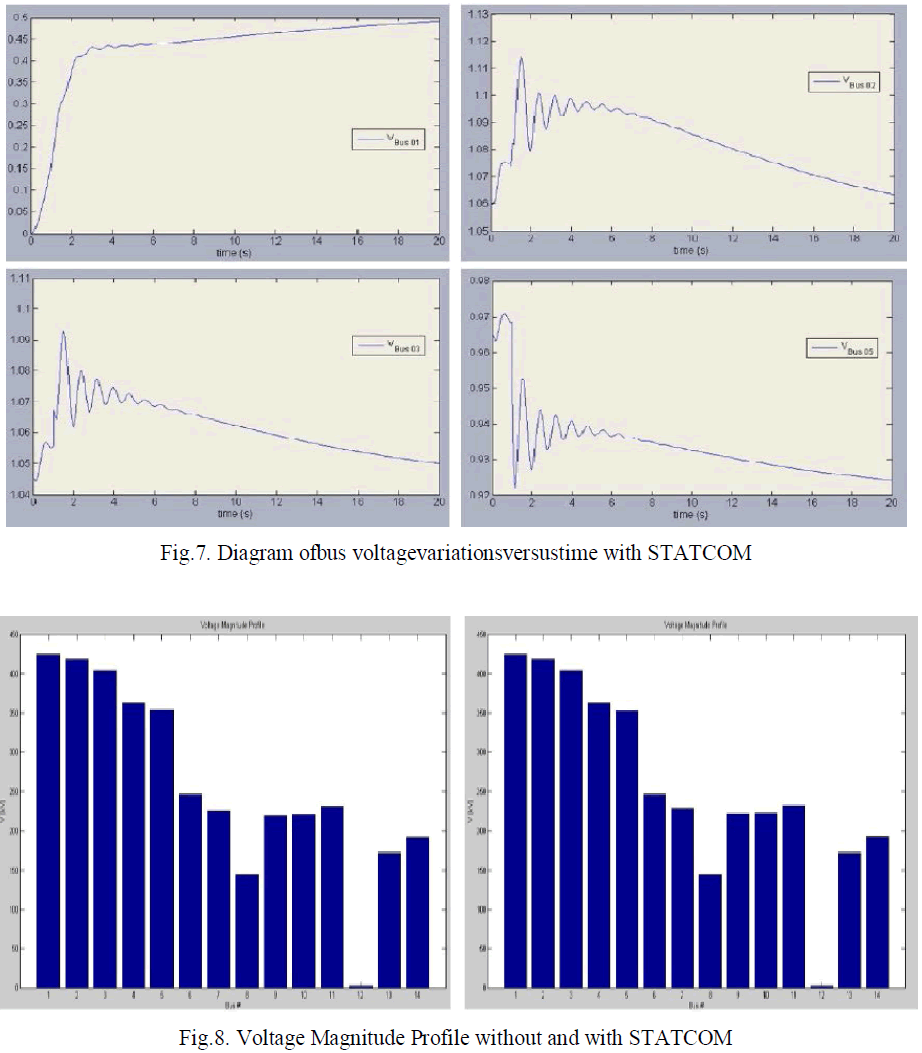 |
CONCLUSION |
| This paper presents that the STATCOM improves static voltage of the buses. STATCOM provides higher reactive power support with a faster response time but is expensive.It has been shown that the STATCOM with real powercapability can be very effective in damping power systemoscillations. SVC, on the other hand, is a cheaper substitute with relatively longer response time. But being capacitor based, the reactive power support to bus falls significantly at the time of fault. Hence, STATCOM provides a robust option. Hence comparison indicates STATCOM is suitable for static as well as dynamic voltage restoration (i.e., STATCOM offers better performance in regulating the Voltage Stability of the system). |
References |
|